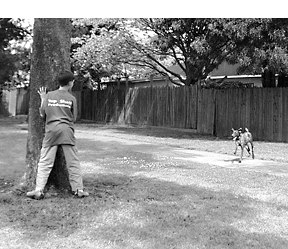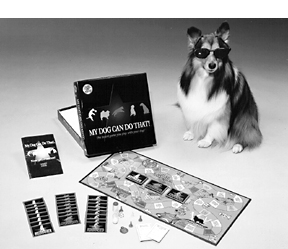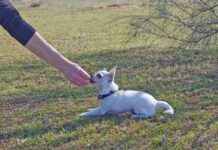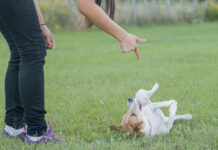Training is about relationship. While basic good manners and other more complex lessons are undeniably an important part of training, the most successful dog/owner teams are those who have cultivated their relationships with each other while they learn the ins and outs of “Sit,” Down,” “Stay,” and all the other things a dog needs to know. In other words, the best teams are those who remember to have fun together along the way.
By the way: Just about everything presented here regarding dogs also applies to puppies – it especially applies to pups! That’s because puppies are irrepressible fun machines. They romp, they play, they chase, they chew, they wrestle – in fact for a good part of your first six to 12 months with your new pup you will probably spend a lot of time trying to convince him to have a little less fun!

Be careful that you don’t go overboard. If you insist that he be too serious, he’ll forget how to play, and you’ll end up with a lump of overweight canine who doesn’t even want to accompany you on your walks around the block. Instead, engage your pup – and later, your dog – in structured games that direct his play-energy into appropriate channels, reinforce his play behaviors, reward his sense of humor, and keep the relationship flames burning bright.
Fun games for Fido go far beyond fetching a tennis ball or a Frisbee. We’re going to assume you know the old stand-bys, and introduce you to some that you may not have thought of. There are games you and Fido can play together, games the whole family can play, and games you and Fido can play with your friends and their dogs. Some of the best games also have practical applications, but don’t let the practical aspects override the play. Have fun!
———-
GAMES FOR YOU AND FIDO:
Ever wonder how those drug dogs do what they do? You can teach your dog to find stuff and wow your friends with his prowess. Dogs’ noses are a bazillion times more sensitive than ours, so this is easy for Fido, once he understands what you want.
Find It!
Step 1: Have Fido wait and watch while you “hide” a strong-smelling treat in plain view, 5-10 feet away from him. Return to his side, tell him to “Find it!” and encourage him to go get the treat. Repeat this a few times until he seems to have the idea. Most dogs catch onto this pretty quickly.
Step 2: Have Fido wait and watch you hide the treat in a less obvious place, such as behind a chair leg, under the edge of a cushion, or next to a toy. Return to his side, tell him to “Find it!” and encourage him to go get the treat. When he can do this, hide several treats while he watches, and keep encouraging him to “Find it!” until he has found them all. Repeat this until he is doing it easily. If he has trouble, don’t show him where the treats are – you will teach him to wait for you to point them out, rather than use his nose to find them himself! Move in the general direction of the hidden treat, but don’t show it to him.
Step 3: Have Fido wait where he can’t see you. Hide several treats in the same places you hid them before. Bring him into the room and tell him to “Find it!” Keep encouraging him until he has found them all. If he has trouble, move in the general direction of the treat, but don’t show it to him.
Step 4: Try “Find it!” with other things – a ball, or a favorite chew toy. Show your dog the ball, have him wait and watch while you hide it in an easy place, then tell him “Find the ball!” Once he gets the idea, hide it without him watching, and tell him to “Find the ball!”
Practical applications: Are you forever forgetting where you left your car keys or the remote control? Let Fido find them for you. Teach him to find your kids, other family members, and friends! Our dog Josie learned how to find lost turtles; we didn’t even realize we were teaching her, but it sure came in handy when our turtles escaped! (See “Is Your Dog Hiding a Talent?” WDJ August 1999.)
If you have a dog who exhibits mild separation anxiety when you leave, you can hide several treats and a stuffed Kong or two. Ask her to “Find it!” just before you leave, and she will be too busy looking for hidden goodies to worry about you leaving.
Caution: Don’t hide treats in places that will encourage your dog to dig into carpets or cushions or chew furniture to get to them.
Jumping Jacks
When I was a kid, my favorite game was to put mop handles and broomsticks across chairs and run through the house jumping over them with my Collie. Great exercise for both of us!
You may not choose to jump over jumps with your dog (although you might be surprised to discover how much fun it is), but you can create jumps from broomsticks, scraps of woods, boxes, and other household items. You can buy materials and build simple jumps if you are handy, or splurge and buy a set of agility or flyball jumps to play with – as long as you promise not to get all serious just because you paid real money for them!
Step 1: Set up one low jump. If your dog is very cautious, just lay the bar on the floor and encourage your dog to step over it by luring him with a treat. As he gets braver, toss treats on one side of the low jump, then the other, until he is jumping it easily. Use lots of verbal praise as well, to keep it cheerful, exciting and fun.
Step 2: When he is jumping the low jump smoothly, add a verbal cue such as “Jump!,” “Hup!,” or “Over!” Start using the cue just before you toss the treat.
Step 3: To fade the use of the treat, make a motion with your hand as if you were tossing the treat, then give the verbal cue. After your dog jumps, then toss the treat. Eventually move to random reinforcement, where he gets a treat sometimes, but not every time he jumps. Remember to use verbal praise – your excitement will keep him enthusiastic about jumping.

Step 4: Gradually raise the jump to a height that is suitable for your dog. Vary the location and type of jumps, so your dog is very jump-versatile. You can hang towels or jackets over jump bars to change the look, put flower pots or children’s toys under them – be creative.
Practical applications: Hopping over small obstacles when you are hiking in the woods; and hey, Lassie jumped over fences when she ran home to tell everyone that Timmy was in the well!
Caution: Puppies should not jump too much or too high; it can damage their soft baby bones and joints. Even adult dogs should jump primarily on giving surfaces (grass, not concrete; carpet, not hardwood floors) with good traction to avoid injury and arthritis, and should not be asked to jump higher than is comfortable and safe for them. Ask your veterinarian how much jumping your dog should do.
Hide and Seek
This is easy and great fun, especially if you start with a young puppy who is still very dependent on you.
Step 1: Take your dog for a walk in an area with some trees and other objects you can hide behind. When he is busy sniffing or bird watching, hide behind a tree. Be quiet and still, but peek out so you can watch him.
Step 2: When your dog notices that you are gone, he should start searching for you. Let him search and find you, then make a big fuss over him with lots of yummy treats, tug with a tug toy, chase a ball, or whatever other reward is very meaningful to him. If he can’t find you or doesn’t look for you, help him – but just a little – by calling his name softly or making some other small sound that will get him started in the right direction.
Practical applications: This game teaches your dog to keep his eye on you – he never knows when you might disappear! It also teaches him to look for and find you if you happen to get separated accidentally.
Caution: Some dogs panic if they can’t find you, especially dogs prone to separation anxiety. Remember to watch your dog, and help him if he is looking anxious, before full-fledged panic sets in. Also, some dogs could care less about where you are. If you think your dog might just run off into the woods when you play this game, keep him on a long line when you hide so you can prevent him from leaving.
———-
GROUP GAMES:
Most of the following games can be played with the whole family, or are games you and Fido can play with your friends and their dogs. If your family has just one dog, pass him from one person to the next. Or get a group of your friends together with their dogs! Some of the following games are great party activities for 4-H or dog training club get-togethers.
Sit Around the World
This game is not only fun, but it also practices that all-important “coming when called” behavior and reinforces polite greetings.
Step 1: Arrange all available human players in a large circle in a safely enclosed area. Begin with Fido sitting in front of one person.
Step 2: Have the next person in the circle call the dog with a cheerful, enthusiastic, “Fido, come!” You can use toys and squeakers initially, if necessary, to get Fido excited about playing the game. When Fido comes, he must sit before he gets his treat reward. Lure the sit, rather than giving the “Sit” cue, so he learns to sit in greeting without being asked.
Step 3: Have the next person in the circle call the dog.
Step 4: When Fido is really good about coming around the circle, you can start calling him randomly across the circle.
Step 5: To play this game as a competition, be sure the humans are equally spaced, and then use a stopwatch to keep track of the time it takes for Fido to come and sit for each person. The holder of the fastest time, or fastest average times, is the winner.
Practical applications: Coming when called and polite greetings – how much more practical can you get? If you have a multi-dog household, try this with two or more dogs at a time, after each dog has learned the game individually.
Caution: If Fido is large and tends to jump up, small children may not be able to play this game until the dog understands the rules.
Musical Sits
For a group of dog people, this is far more fun than the human-only version of musical chairs. It can be played on several different levels, from beginner to advanced. As a another variation, each game can be played with downs instead of sits.
Easy version: Have dogs and handlers walk to the music around orange cones in a large circle. When the music stops, all players ask the dogs to sit. Luring with treats is allowed; physically forcing the dogs to sit is not. First dog to sit wins! Repeat until everyone has had enough play.
Intermediate version: Space rug sample squares evenly around a large circle, with one fewer rug than there are dog/handler teams. Have dogs and handlers walk to the music, outside the circle of rugs. When the music stops, players must proceed to the next available rug square and have their dogs sit. The team that doesn’t get a rug is out. Repeat until one team wins.
Advanced version: Set out a double line of chairs back to back, in the center of the room, with one fewer chair than dog/handler teams. Put rug sample squares in a large circle around the chairs, one rug per team. Have dog and handlers walk to the music outside the circle of rugs. When the music stops, players must proceed to the next available rug, put their dogs on a sit-stay, and run for a chair. Player who doesn’t get a chair is out. However, if a dog breaks his sit-stay, the player must return to the dog, re-establish the sit-stay, and then return to her chair. Meanwhile, of course, another player can sit in the chair.
Practical applications: Great opportunity to practice leash-walking in groups, fast sits, downs, and reliable stays with lots of distractions.
Caution: Players can get pretty enthusiastic with this game. You may need to establish safety rules based on the footing of the play area, and the energy level, size, and strength of various players.
Diving For Dogs
Our Pomeranian loves this one so much that he starts trembling with joy and anticipation when he sees us setting it up!
Step 1: Slice several hotdogs into an equal number of pennies. Keep each hot dog separate from the others.
Step 2: Put 2 to 12 inches of water in a pan or tub. Small dogs will require a shallower “pool.”
Step 3: Drop one hot dog’s worth of pennies into the pan. Let the dog watch you do this. Be sure he knows they are hotdogs.
Step 4: With your stopwatch in hand, say, “Ready, set, go!” and start the stopwatch. On “Go,” the handler releases the dog and encourages him to get the hotdogs out of the water and eat them. The dog who eats all his hotdog pieces the fastest wins.
Practical applications: None I can think of, but it sure is fun and the dogs love it! Actually, if you want to teach your dog to retrieve under water, this can get him started.
Caution: I have never seen it happen, but you might want to watch for a dog who risks drowning himself while “diving for dogs.” Stop the game if a dog starts sputtering.
My Dog Can Do That
This is a commercially produced board game that you play with your dog. The game consists of three decks of cards – beginner, intermediate, and advanced. Any dog with basic good manners training can play.
Each card has a behavior described on it that you have to try to get your dog to do – from simple “Sit on a verbal cue” from the beginner deck, to “Pick up a toy and drop it in a basket” in the advanced deck. The value is listed on the card (3 spaces, 5 spaces, 12 spaces, etc.); generally the more difficult the behavior, the higher the value.
You have 30 seconds to get your dog to perform the task on the card you’ve drawn. If you and your dog succeed, you can move your marker that many spaces on the board (or earn that many points, if you just keep score).
If you don’t succeed, the next player in line – if she thinks her dog can perform the behavior – says “My Dog Can Do That!” (It is perfectly acceptable to use a superior tone of voice when saying “My Dog Can Do That!”) If she and her dog succeed, she moves double the number of spaces or earns double the number of points. The team that reaches “Finish” on the board or who has the most number of points at the previously agreed-upon ending time of the game, wins.
My Dog Can Do That is available from many pet supply sources, including DogWise (www.dogwise.com or 800-776-2665).
Practical applications: Lots of opportunities to practice a wide variety of good manners behaviors. Great motivator for teaching your dog tricks, including “Roll over,” “Say your prayers,” and “Balance a treat on your nose.”
Caution: Official rules say to play off-leash. Depending on level of players and security of your playing field you may want to modify this to allow leashes some or all of the time.
———-
Personal preferences
Different types of games appeal to different human and canine personalities. There are many more games to be played than the ones we have described for you here, although we hope you found some that you like. Talk to your dog friends and see what ideas they have. Look up “dog training games” on the Internet and see if you can find more. Pick out the ones you and your dog are most likely to enjoy, gather the equipment you need to set them up – and then go play in the yard!






